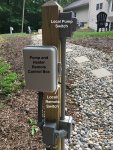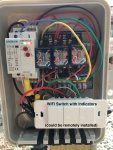While I was waiting out the winter, longing for days on the pool deck with a cold beverage, I opted to put together a system to manage scheduling of pump cycles in conjunction with operating a gas heater. I run a single-speed 1 HP Pentair pump and a Rheem 206 gas heater.
I had a few requirements/desires:
1) WiFi controllable so that I could use my phone from anywhere, voice commands in the house, etc. to do the operations.
2) If the heat is enabled and the pump is shut off, the heater is turned off first and the pump continues to run for a fixed delay before turning off in order to cool the heat exchanger prior to shutdown.
3) Ability to toggle between pool and spa mode on the heater. We don't have a spa but early spring and late fall, when the weather is cool, it isn't unusual to be at work and notice it might be a nice evening for swimming and you'd like to raise the temp to say 90F so the pool is ready when you get home.
4) Ability to easily bypass the system so I didn't have to fiddle with my phone to backwash, rinse, etc. while standing on the equipment platform for my pool.
If there was an off the shelf solution available for $100 or so, I probably would have gone for it, but I wasn't able to find anything suitable. Things that did #1 and #4 couldn't easily do #2 or #3. I opted to build something myself and thought I'd share plans and photos in case anyone else is interested.
Warning: electricity can cause injury or death, damage equipment, start fires, etc. Do not attempt any electrical modifications or operations if you are the slightest bit uncertain about your abilities. Use the information here at your own risk. It comes without warranty. I assume no liability for any mistakes in the information or consequences that may result from its use. Consult and obey all electrical codes. Electrical modifications should only be made by a qualified electrician.
In order to allow easy control with commodity WiFi switches, I opted to build a system that used 120 VAC control voltage and therefore used relays with 120 VAC coils. I wanted three inputs from a WiFi switch: pump on, heater on, and temperature boost. The desirable behavior of these 120 VAC inputs is roughly as follows:
To supply the three inputs above I used a three-button WiFi switch. I opted for a single-gang configuration with the plan of putting this switch closer to the house in a weatherproof receptacle box, but I ran into trouble fishing wire through a long conduit run. At present the switch is inside the same box with the relays, and it works fine. The design allows for the control switch to be on an independent circuit from the control box itself since this is what I was originally building for. One critical component: the hot line to the WiFi switch must be fused to enable the use of fine gauge wire in the control circuit.
I also needed a manual toggle switch, and that was one to be externally mounted on the control box to disable the whole box and return pump control to the manual switch that was installed by the builder. I needed to be rated at 15A (for my application) or higher, DPDT, and weatherproof.
I was able to build the control box from a standard plastic telecom box readily available on Amazon. The relays are all DIN rail mounted so I put in DIN rail in this box. I then added a jumper block to easily allow connections in the field.
The interface with the heater is very well documented in the manual. The heater provides 24 VAC and you must either connect this 24 VAC to pool or spa pins on the remote cable to enable pool or spa mode. I was also able to use this 24 VAC as a power source for the time-delay relay. It needs external power and almost everything else in the system is being switched off or on. The heater manual recommends twisted pair cable for the remote connection. I opted for 18 AWG thermostat control cable. My pump and heater are on the same electrical circuit so the two share a common ground at the work box on the platform. I also grounded them through the cable. The heater came with a header and "pigtail" on the control board that is ready to splice right into the remote control cable. I just used a simple crimp-on butt splice for that connection.
I've had the box running now for 2+ months and had no issues. I get a charge out of seeing my 5-year old scamper out of the pool, open the door to the house and shout "Alexa, turn the temperature boost on!" and then get back in the pool and giggle when hot water starts coming out of the jets.
Attached are some circuit diagrams and photos. You can find most part numbers in the photos. If you opt to build, mind the coil voltage rating on the simple relays -- you need coils built for 120 VAC.
The typical current draw on my 1HP pump is less than 12 A, and it is was installed in the 120 VAC configuration. If you are running a 240 VAC installation or a significantly higher horsepower pump you may need to modify components of the circuit, or this approach might not work well at all.





I had a few requirements/desires:
1) WiFi controllable so that I could use my phone from anywhere, voice commands in the house, etc. to do the operations.
2) If the heat is enabled and the pump is shut off, the heater is turned off first and the pump continues to run for a fixed delay before turning off in order to cool the heat exchanger prior to shutdown.
3) Ability to toggle between pool and spa mode on the heater. We don't have a spa but early spring and late fall, when the weather is cool, it isn't unusual to be at work and notice it might be a nice evening for swimming and you'd like to raise the temp to say 90F so the pool is ready when you get home.
4) Ability to easily bypass the system so I didn't have to fiddle with my phone to backwash, rinse, etc. while standing on the equipment platform for my pool.
If there was an off the shelf solution available for $100 or so, I probably would have gone for it, but I wasn't able to find anything suitable. Things that did #1 and #4 couldn't easily do #2 or #3. I opted to build something myself and thought I'd share plans and photos in case anyone else is interested.
Warning: electricity can cause injury or death, damage equipment, start fires, etc. Do not attempt any electrical modifications or operations if you are the slightest bit uncertain about your abilities. Use the information here at your own risk. It comes without warranty. I assume no liability for any mistakes in the information or consequences that may result from its use. Consult and obey all electrical codes. Electrical modifications should only be made by a qualified electrician.
In order to allow easy control with commodity WiFi switches, I opted to build a system that used 120 VAC control voltage and therefore used relays with 120 VAC coils. I wanted three inputs from a WiFi switch: pump on, heater on, and temperature boost. The desirable behavior of these 120 VAC inputs is roughly as follows:
- pump on: when closed, this turns the pump on regardless of the configuration of the other switches; when opened, if heater is on, then the pump runs for 5 minutes before shutting off, otherwise it shuts off immediately
- heater on: enables the heater when closed and switches pump control from a standard contactor to a time-delay relay; when open there is no heat, independent of the state of the temperature boost switch
- temperature boost on: toggles between pool (switch open) and spa (switch closed) modes on the heater, each of which has an independent set point
To supply the three inputs above I used a three-button WiFi switch. I opted for a single-gang configuration with the plan of putting this switch closer to the house in a weatherproof receptacle box, but I ran into trouble fishing wire through a long conduit run. At present the switch is inside the same box with the relays, and it works fine. The design allows for the control switch to be on an independent circuit from the control box itself since this is what I was originally building for. One critical component: the hot line to the WiFi switch must be fused to enable the use of fine gauge wire in the control circuit.
I also needed a manual toggle switch, and that was one to be externally mounted on the control box to disable the whole box and return pump control to the manual switch that was installed by the builder. I needed to be rated at 15A (for my application) or higher, DPDT, and weatherproof.
I was able to build the control box from a standard plastic telecom box readily available on Amazon. The relays are all DIN rail mounted so I put in DIN rail in this box. I then added a jumper block to easily allow connections in the field.
The interface with the heater is very well documented in the manual. The heater provides 24 VAC and you must either connect this 24 VAC to pool or spa pins on the remote cable to enable pool or spa mode. I was also able to use this 24 VAC as a power source for the time-delay relay. It needs external power and almost everything else in the system is being switched off or on. The heater manual recommends twisted pair cable for the remote connection. I opted for 18 AWG thermostat control cable. My pump and heater are on the same electrical circuit so the two share a common ground at the work box on the platform. I also grounded them through the cable. The heater came with a header and "pigtail" on the control board that is ready to splice right into the remote control cable. I just used a simple crimp-on butt splice for that connection.
I've had the box running now for 2+ months and had no issues. I get a charge out of seeing my 5-year old scamper out of the pool, open the door to the house and shout "Alexa, turn the temperature boost on!" and then get back in the pool and giggle when hot water starts coming out of the jets.
Attached are some circuit diagrams and photos. You can find most part numbers in the photos. If you opt to build, mind the coil voltage rating on the simple relays -- you need coils built for 120 VAC.
The typical current draw on my 1HP pump is less than 12 A, and it is was installed in the 120 VAC configuration. If you are running a 240 VAC installation or a significantly higher horsepower pump you may need to modify components of the circuit, or this approach might not work well at all.





Last edited:


